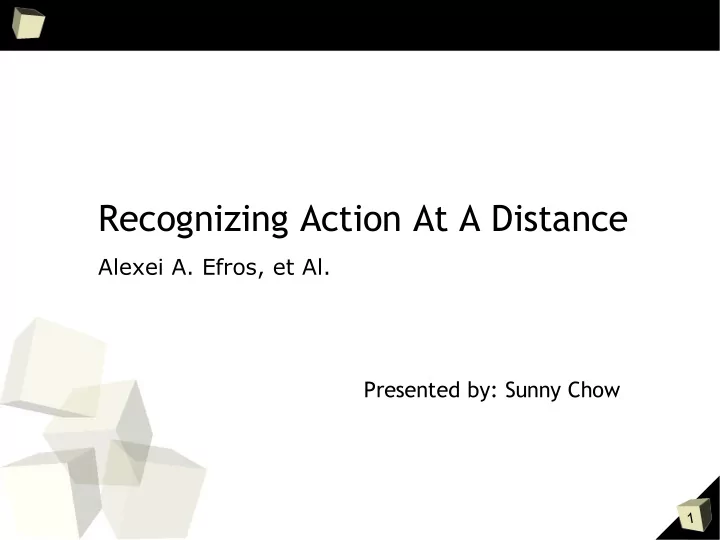

Recognizing Action At A Distance Alexei A. Efros, et Al. Presented by: Sunny Chow 1
Background ■ We are adept at classifying actions. Easily categorize even with noisy and small images ■ Want computers to do just as well ■ How do we do it? 2
Motivation ■ Possible applications for action recognition Obvious ➔ Tracking people's activities in public places Less obvious ➔ Use classification to solve a harder problem - Put a skeletal model over the novel sequence - Synthesize actions 3
Related Work ■ Action classification has been attempted in the past, with different assumptions Most work in nearfield ➔ Shah and Jain – Track Body Works Motion periodicity ➔ Cutler and Davis – Poor quality moving footage 4
Scoreboard ■ Assumptions Tracking and Image Stabilization is taken care of. Figure-centric sequence of images as input Human actions ■ Conditions Image sequence from mid-field Different start and End points Different rate of motions Independence of appearance ➔ Actor ➔ background 5
Approach ■ Comparison between novel and classified, stored images ■ Need to choose representation ■ Based on optical flow ■ Spatial-Temporal Descriptor 6
Quick Review of Optical Flow ■ Given: two frames of a video scene closely separated in time. ■ Goal: Get motion of each pixel. ■ Motion field, noisy. Certain measurements are better than others. 7
Quick Review of Optical Flow 2 ■ Measure only relative motion between frames. ■ Indifferent to actual appearance. ■ Failure modes Specularities sit still Large displacements 8
Problems with Optical Flow ■ 1. Data is noisy Novel idea: Treat vectors as “noisy measurements” which can be added up later ■ 2. Data may not be properly aligned in space/time Just blur. Treat positive values and negative values separately. 9
Motion Descriptor ■ Spatial-Temporal descriptor 4 channels per image in a sequence ➔ Gradients in X and Y separated into positive and negative channels. 0 1
Comparison ■ Use normalized correlation to compare motion descriptors ■ Interested in sequence of images. Start and end of novel sequence unknown Rate of action unknown ■ String channels from the sequence together ■ Similarity Matrix: 1 1
Comparison Intuition ■ Consider one channel at a time. Same rate, different starting times. Suppose a started at 1, b started at 2 2 1
Comparison Intuition 2 ■ Different rates, use “Blurry Indentity” kernel 3 1
Comparison ■ S_ff ■ Final Similiarity Matrix 4 1
Algorithm Outline 5 1
Results ■ Test Sequences for Ballet and Tennis 6 1
Results ■ Test Sequence for Football 7 1
Action Synthesis ■ Do as I do... Query with novel action sequence, create a similar sequence using stored data 8 1
Action Synthesis ■ Do as I Say Query with action identifier (english description), create an action sequence. Think Mortal Kombat 9 1
Additional Applications ■ Skeletal Model ■ Figure Correction Find stored motion descriptor closest to data Common parts: what we're interested in Variations: noise occlusion. Use to correct 0 2
Summary ■ Novel observation, optical flow can be treated as noisy measurements ■ Create spatial-temporal descriptor to represent action ■ Use descriptor as a query into a database of classified actions to classify novel action ■ Use database to solve harder representation problems 1 2
Unanswered Questions ■ Querying into database seems computationally expensive. ■ Unclear on granularity of representation of the motion descriptors ■ How well does this algorithm compare to a human's ability to classify actions? ■ How to determine the size of temporal window? ■ How much does background movement affect the results? 2 2
But that's not all, folks, wait and see what else you will get! 3 2
2 for 1 special, today only! ■ Detecting Pedestrians Using Patterns of Motion and Appearance Paul Viola, Michael Jones, et al. 4 2
Huh? What is this about? ■ Allows detection of specific features in an image ■ Feature of interest: moving pedestrians Detects pedestrian as small as 20x15 ■ Extremely fast, 15 fps 5 2
So what's different? ■ No tracking or stabilization assumptions ■ Will detect only moving pedestrians ■ Static image ■ Uses only short term patterns of motion 6 2
High level summary of methods ■ Based largely on previous work,”Rapid Object Detection using a Boosted Cascade of Simple Features” Primary purpose: detecting faces from a picture ■ 3 parts: “Integral Image” Learning algorithm based on “AdaBoost” Combining increasingly complex classifiers into a cascade. 7 2
Filters! ■ Features represented as filters Simple Scale easily 8 2
Filter Intuition ■ Filter intuition 9 2
Filter application ■ Use these filters to classify both motion & intensity ■ Use AdaBoost to combine various filters into classifiers Goal: balance intensity, motion information, maximize detection rates 0 3
Classifiers ■ String classifiers together ■ Simple to Complex ■ Simple: weed out things that look nothing like what we're interested in. 1 3
Classifiers 2 ■ For each stage, since simple to complex ■ Both false positive rates and detection rates decrease ■ Trick: get false positive rates to decrease faster than detection rate. 2 3
Classifier Intuition 3 3
Accuracy 4 3
Results 5 3
Results 1 ■ Through rain or snow... 6 3
Thanks for your time! 7 3
Recommend
More recommend